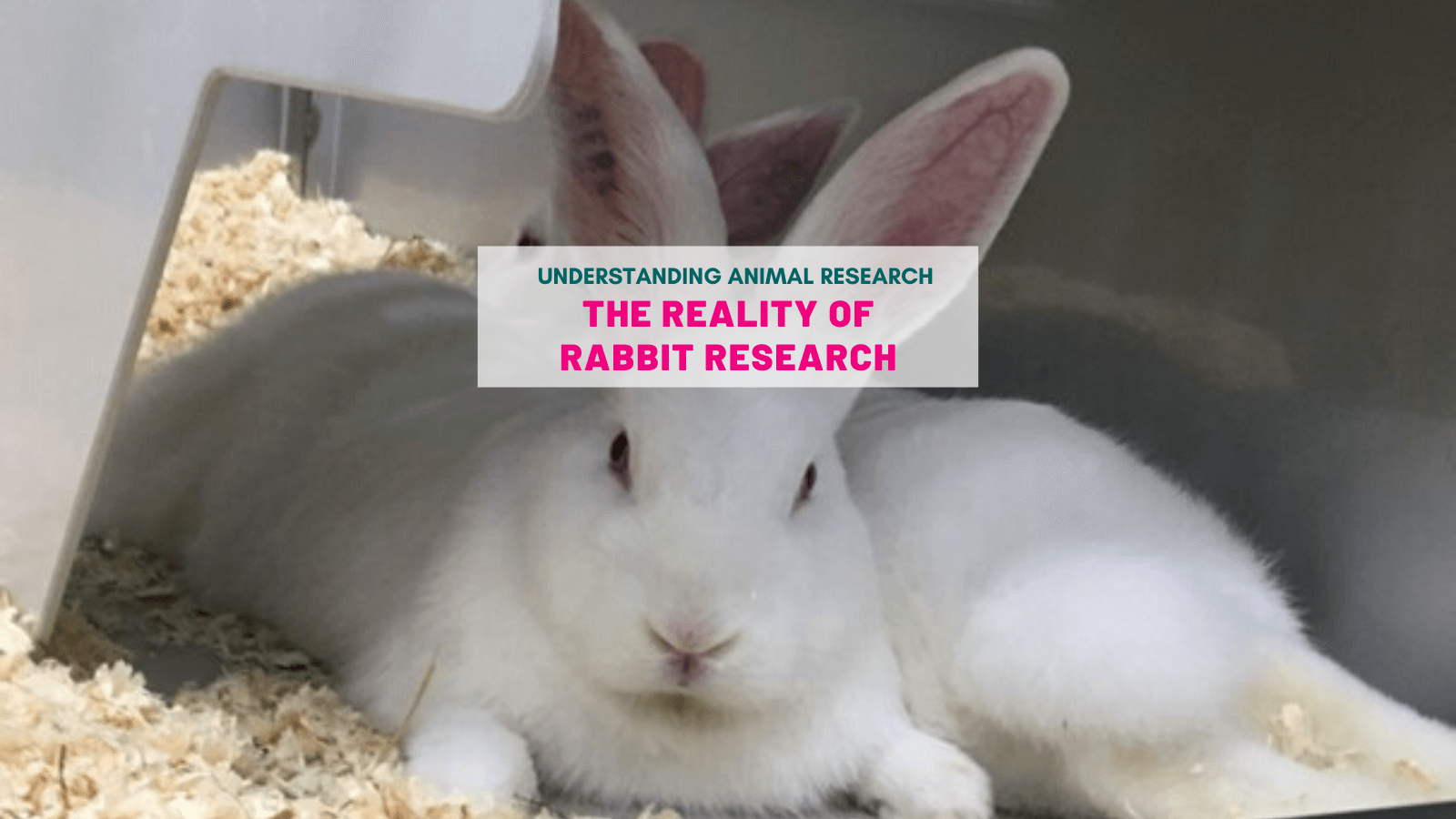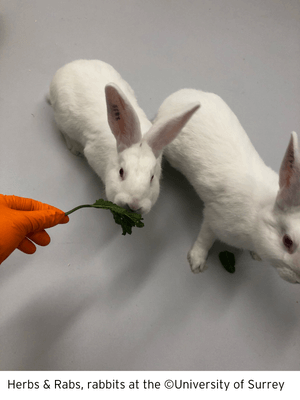
Rabbits are the classic poster child for outdated and badly portrayed cosmetic testing campaigns. But did you know that the use of rabbits – and other animals – for cosmetic testing has not been allowed in the UK or EU for more than a decade!
Testing cosmetic products and their ingredients on animals was banned in the UK in 1998 and across the EU in 2013, and replaced with non-animal methods. To date, rabbits are still used in research, but only to further scientific and public health knowledge, and their care and welfare are strictly overseen by animal technicians and veterinarians.
Rabbits in research
In the UK, rabbits are involved in approximately 2.5% of all scientific procedures involving animals, most of which are used in antibody research, including analytics, diagnostics, and production.
The rabbit immune system can recognise a much broader range of antigens than rodents, while generating antiserum that contains a high volume of antibodies with increased sensitivity and affinity towards antigens of human origin. Their larger size also means they can produce significantly more antiserum than rodents. These characteristics often make rabbits more frequently used in antibody research compared to other animals.
Historically, rabbits were used to develop Louis Pasteur’s rabies vaccine. Today, rabbits still play a fundamental role in fighting infectious diseases. Rabbits display a general physiology, similar to that of humans, and like mice and rats, suffer from many diseases with human equivalents. For example, young rabbits often die from a disease called mucoid enteritis, a condition that shares disease mechanisms like those seen in individuals suffering from cystic fibrosis, and the diarrheal disease, cholera.
The World Health Organisation estimates that half a million children under five years old die each year because of diarrheal disease therefore, rabbits have been used by researchers at the University of Surrey and elsewhere to study this disease. Some of the bacterial organisms responsible for causing human disease do not cause clinical signs in rodents, necessitating the use of rabbits when investigating disease mechanisms and novel therapeutics.
“Rabbits were used because they gave the best representation of the human condition (in terms of diarrheal disease), as opposed to mice for example,” explains the University’s Named Information Officer (NIO).
The rabbit has also been important in the study of cardiovascular disease, particularly hypertension and atherosclerosis, as they naturally develop arterial plaques in response to a high-cholesterol diet. Studies in rabbits remain key in many aspects of medical research, including cancer, glaucoma, ear infections, eye infections, skin conditions, diabetes and emphysema.
In the UK, the majority of animal procedures involving rabbits are classified as mild, meaning that the animal experiences short-term pain, similar to an injection or having a blood sample taken. However, a small number of experiments with rabbits involve moderate or severe suffering. Moderate experiments cause a significant disturbance to the animal’s normal state, for example, surgery carried out under general anaesthesia followed by painkillers during recovery. While severe experiments cause a major departure from the animal’s usual state of health and well-being, for example, long-term disease processes where assistance with normal activities such as feeding and drinking were required.
Huge efforts are made to minimise the pain and distress experienced by animals, but sometimes the experimental setting requires these procedures to take place. Research projects involving animals are only ever granted approval by the Home Office when there is not a suitable non-animal method, and when the potential benefits of the research outweigh the potential animal suffering.
Rabbit welfare in the laboratory
Over the years, the welfare of animals kept in labs for scientific purposes has greatly improved. Today, a lot of thought goes into the care of animals; mice, rats, guinea pigs, rabbits and other animals, alike. A team of well-trained and qualified animal technicians make sure that each and every animal's physiological needs are met within the framework of the animal experiments that are pursued. 
Many animals, including rabbits, are social animals that need room to exercise. “The image of the rabbit stuck in the cage is very much an outdated one,” the NIO at the University of Surrey told us.
“When rabbits were housed at the University a few years ago, they were kept collectively in floor pens with soft bedding and various enrichments to stimulate the animals”.
The University’s Named Animal Care and Welfare Officer (NACWO) added that “the rabbits were given dried vegetable bites to nibble on, tunnels to race into and hide, hay that they could eat, burrow and play with, different beddings to forage and cardboard that they could shred and keep busy with”.
However, some experiments may require that rabbits are kept singly housed, for example, if the animals are shedding infectious material. In this situation, rabbits are kept for short periods in cages in a biological containment facility, where they receive as many of the enrichments as can be safely given in that environment.
“Because of infection control concerns in the containment facility, it isn’t possible to have loose bedding on the floor of the cages” stated the NACWO. “But we do continue to cater for their needs by giving them raised areas to climb on so they are using their legs and building muscle, hay to nest with, and a shelter so the animals can hide, for example.”
Over the last five years, floor pens, or equivalent social housing systems, have become the norm in the UK and are a welcomed standard for housing rabbits.
“You see that the animals are a lot more relaxed in these housing systems, just by the way they react when anyone enters the room,” explains the NACWO. “The floor pens take up a lot more space and are more difficult to clean, but they are worthwhile. Even commercial rabbit breeders, from which we receive the animals, are keeping their rabbits in groups for welfare purposes” added the NIO.
A culture of care
“Rabbits are social animals that are often kept as pets. Working and interacting with them in a floor pen setting where they are relaxed and comfortable with their handler is very rewarding,” shares the NACWO at the University of Surrey. “We feel empathy for the animals, and recognise and appreciate their individual characters. It is a real pleasure and privilege to work with them.”
The animal technicians also engage in activities with the rabbits, to improve their quality of life, even when they’re not involved in a research protocol.
“There are many activities that are put in place to keep the animals stimulated, and the animal technicians at the University of Surrey spent a lot of time with them,” explains the NACWO.
The animal technician’s also make sure the animals are at ease with handling. Because the rabbits are part of research experiments, they are often held, moved about and checked. They need to be comfortable in different settings.
“We use positive reinforcements in the research setting so the rabbits are, for example, eager to step on scales or trolleys to get treats, or comfortable around noises in the research environment,” further explains the NACWO. “Taking the time to get the animals used to their immediate environment helps the animals be more relaxed, and this makes it easier for the researchers working with them to collect data.”


The positive impact of better animal welfare on science
The importance of good housing and husbandry is recognised in legislation and guidelines on the use and care of animals in science. Having less stressed animals and better welfare also has a positive influence on the resulting science.
“It is easier to interact with the animals and generate reproducible data when they are at ease in their environment, less stressed and well cared for,” explains the NIO. “It doesn’t necessarily change how the pathogen causes disease, but stress could suppress or enhance normal physiological processes and impact infection outcomes, leading to more variable data. In addition, it is easier to spot abnormal behaviours in healthy animals.”
Good animal welfare is intrinsic for good science. It improves the quality of research data derived from laboratory animals, their validity as models of human disease, the number of animals required to reach statistical significance, and the reproducibility of in vivo studies. Animal welfare science that explores the well-being of animals that are managed by humans, helps improve animals' lives in an evidence-based way, but also improves the science that is backed by these research animals.
Read more about rabbits in scientific research.
Last edited: 23 January 2023 15:50



